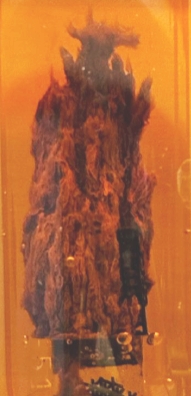
Injection chemical garden experiments have been used to produce laboratory analogs to seafloor hydrothermal chimneys on Earth and ocean worlds. These systems form self-assembled inorganic membranes via precipitation of metal oxyhydroxides, silicates, and/or sulfides when hydrothermal fluid simulant is slowly injected into a seawater simulant. In certain reaction systems, this nonequilibrium precipitation generates fragile structures which exhibit microstructural weakness from multiple competing crystallites, non-epitaxial growth, loose agglomeration and poor sintering of particles, hindering the extraction and study of the chimneys. To improve control and robustness of simulated chimney structures we developed a new method of precipitating chemical gardens within 3D scaffolds composed of hydrothermally-relevant minerals (e.g., Opal-A), in order to enable intact extraction and improved in- and ex-situ characterization of the precipitated structures. The scaffolds were fabricated using vat stereolithography, allowing tailored control over the direction of the precipitation reaction front. We tested three open-cell architectures of scaffolds (square cubic, inverse opal, and Voronoi) that facilitated flow- through of hydrothermal fluid simulant and structurally supported the precipitated hydrothermal chimneys. Using mineral-fillers to provide surface roughness for nucleation, our scaffolds permitted stable growth of hydrothermal chimney analogues at accelerated rates up to 3 mL/min (~300-500x) compared to previous lab-scale analogues. These 3D flow-through scaffolds successfully augmented injection chemical garden experiments simulating hydrothermal chimneys by providing architectural strength for more physically stable chimney growth. This enhanced precipitate stability opens future avenues for studying the growth, evolution and alteration of simulated hydrothermal precipitates.

FeO(OH) chimney on a scaffold